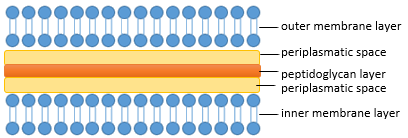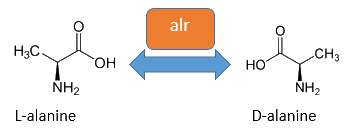Team:Bielefeld-Germany/Biosafety/Biosafety Strain
From 2013.igem.org
| Line 167: | Line 167: | ||
==Results== | ==Results== | ||
| - | [[Team-Bielefeld-Biosafety-Strain-araCharacterization.jpg|center | + | [[Team-Bielefeld-Biosafety-Strain-araCharacterization.jpg|center'''Figure x:''' araC ]] |
Revision as of 12:36, 3 October 2013
Safety Strain
Overview
The basic for our Safety-System is an auxotrophic Safety-Strain. In this Safety-Strain the constitutive Alanine-Racemase (alr) and the catabolic Alanine-Racemase (dadX) are deleted. As the Alanine-Racemase catalyses the reversible isomerization from L-alanine into the enantiomer D-alanine our safety-strain is no longer able to synthesis the essential amino acid D-alanine. D-alanine is an essential molecule for the gram-negative bacteria E. coli, because it is responsible for the cross-linkage of the peptidoglycanlayer, so that a lack of D-alanine inhibits cell division and leads to cell lysis in growing bacteria. This effect is comparable to bacteristatic characteristic known from beta-lactam-antbiotics.
An important parameter, when expressing toxic gene products, like the Rnase Ba, is the maintenance of the plasmid stability. The strict dependance on D-alanine is used to increase the plasmid stability, when the plasmid contains the coding sequence for the Alanine-Racemase (alr) and no D-alanine is supplemented. Therefore the plasmid is necessary for the growing, because otherwise the bacteria are not able to grow. So by using this System it is more certain that the plasmid with the txic gene product is kept by the cell. Additional this causes a double kill-switch system, because now not only the Barnase would imply cell death, but also the loss of the Alanine-Racemase (alr) from the plasmid.
Another deletion concerns the araC gene, the repressor of the arabinose promoter pBAD. As the araC protein functions not only as a repressor but also as an activator a strain with this mutation can be used to amplify a plasmid with a toxic gene product under the control of this promoter without causing cell death. This huge advantage is only possible, because the araC protein, as activator, is absolutely necessary for the initiation of transcription at this promoter. Besides the deletion of the araC gene decreases the amount of repressors when using the Biosafety-System so that the very tight repression of the pBAD promoter is a little bit relaxed and the expression of the toxic gene can so be fine tuned by investigation of different strains.
Theory
The cell wall is essential for every living bacteria, because it divides the Cytoplasm from the environment. In fact the life of the bacteria is only possible because of this separation. In one hand the cell wall confers stability and structure and on the other hand its possible to build up the osmotic pressure and to regulate the transport of molecules across the cell wall.
The composition of the cell wall differs between the bacteria, so that the bacteria generally are divided into gram-negative Bacteria, for example Escherichia coli and gram-positive Bacteria for example Bacillus subtillis. Gram-negative bacteria therefore are characterized by an inner plasma membrane, a thin peptidoglycanlayer, a periplasmatic space an the outer membrane. While gram-positive bacteria in contrast poses only one membrane but a thicker peptidoglycanlayer (see figure below).
Therefore it becomes clear that the peptidoglycanlayer is an interesting approach to control the bacterial growth. Peptidoglycan itself is a polymer consisting linear chain of polysaccharides and short peptides. The polysaccharides component consists of alternating residues of beta-(1,4) linked N-acetylglucosamine and N-acetylmuramic acid and they are cross-linked in E. coli by a tetra-peptide of L-Alanine, D-glutamic acid, meso-diaminopimelic acid and final D-alanine. The cross-linkage is thereby realized by a transpeptid-linkage of meso-diaminopimelic acid and D-alanine.(Cava et al., 2011)
This shows that D-Alanin is an essential component of the bacterial peptidoglycanlayer. In conclusion a lack of D-Alanin would have a bacteriostatic characteristic, comparable to beta-lactam-antibiotic, because it inhibits the building of the peptdiglycan-linkage. Therefore the bacteria without D-Alanine could not divide, because they will lyse otherwise.
The accumulation of D-alanine in E. coli can be catalyzed by an Alanine-Racemase (EC 5.1.1.1). This enzyme catalyses the reversible reaction from L-alanine into the enantiomer D-alanine. For this reaction the cofactor pyridoxal-5'-phosphate (PLP) is also typically needed. In E. coli exists thereby two Alanine-Racemases. One Alanine-Racemase (alr) is constitutive expressed and therefore normally responsible for the accumulation of D-Alanine, while the Alanin-Racemase (dadX) is under control of the dad-Operon and only transcripted in deficient situations (Walsh et al., 1989).
The deletion of the constitutive Alanin-Racemase (alr) and the catabolic Alanine-Racemase (dadX) will lead to a strict dependence of D-Alanine, so that the bacteria with this mutations are only able to grow on media with D-alanine supplemention or by complementation of the Alanin-Racemase on a separate plasmid. As shown in the figure below the D-Alanin-Auxotrophic mutant shows a strict dependence on D-Alanine.
Genetic Approach
For the construction of our Biosafety-System-Strain we deleted both Alanine-Racemases via homologous recombination with the pKO4 (a derivation from the pKO3 containing the coding sequence of the lacZ-alpha Fragment) to establish a D-alanine-auxotrophic mutant. For the deletion of the Alanine-Racemase we thereby used the following primers.
The primers alr_Ec_d1 and alr_Ec_d2 will amplify an about 600 bp long homologous fragment upstream of the coding sequence of the Alanine-Racemase, while the primers alr_Ec_d3 and alr_Ec_d4 will perform an about 600 bp long homologous fragment downstream of the corresponding Alanine-Racemase. This two deletion-sides can be ligated by Gibson-Assembly or alternative classically by gene SOEing (Gene splicing overlap Extension). Then the deletion-sides of the Alanine-Racemase were cloned into to vector by using the bold primer-overhang (see box below).
By following the protocol for the double-cross over using the heat-sensitive RepA protein and the sacB-Gene from the vector pKO3, the two Alanine-Racemases could be successfully deleted (Link et al., 1990).
Primer for the complete deletion of the constitutive Alanine-Racemase (alr) and the catabolic Alanine-Racemase (dadX) in E. coli
Primer: alr_Ec_d1 (39 bp)
5'-TAGCTCACTCATTAGGCACCCAGCTCGATGACGAAGACT-3'
Primer: alr_Ec_d2 (20 bp)
5'-GCCGCTTGCATTTGTGTTCC-3'
Primer: alr_Ec_d3 (40 bp)
5'-GGAACACAAATGCAAGCGGCTTGATTGTCTGTGCCGGATG-3'
Primer: alr_Ec_d4 (40 bp)
5'-GCTTTCTACGTGTTCCGCTTCCGGGAAGTAGCGTTTCAGG-3'
Primer: dadX_Ec_d1 (39 bp)
5'-TAGCTCACTCATTAGGCACCTGAAGTGTGGCGATGAAGT-3'
Primer:dadX_Ec_d2 (20 bp)
5'-GGGTCATCTCGTTTCCTTAG-3'
Primer: dadX_Ec_d3 (40 bp)
5'-CTAAGGAAACGAGATGACCCACTTGTTGTAAGCCGGATCG-3'
Primer: dadX_Ec_d4 (40 bp)
5'-GCTTTCTACGTGTTCCGCTTCGAAGCCAGCGCCAAATATG-3'
To verify the deletion of the Alanine-Racemases in E. coli we designed some additional primers, which anneal outside the deletion region so that a successful deletion can be seen by a 1370 bp (alr) or a 1312 bp (dadX) amplified DNA-fragment, while the wild type shows typically a DNA-fragment with a length of 2439 bp (alr) or 2375 bp (dadX). The primers for the control are listed in the box below.
Primer for the control of the successful Deletion of the constitutive Alanine-Racemase (alr) and the catabolic Alanine-Racemase (dadX) in E. coli
Primer: alr_Ec_control1 (20 bp)
5'-GCTGGAGATGCCATCAGAAC-3'
Primer: alr_Ec_control2 (20 bp)
5'-CCGGCGAATATTGCTACGTG-3'
Primer: dadX_Ec_control1 (20 bp)
5'-GCTTTAATACGCCCGTTGAC-3'
Primer: dadX_Ec_control2 (20 bp)
5'-CTGGATCAACGCTTCTTTGG-3'
In addition to the deletion of the Alanine-Racemaes we deleted the coding sequence for araC in the Safety-Strain. As the araC protein is the repressor of the pBAD (Arabinose) promoter this mutation effects only the Biosafety-System araCactive, but is very useful because of two reasons. In one hand the repressor araC works also as an activator, so that there is no basal transcription behind the pBAD promoter in the strain E. coli K-12 Δalr ΔdadX ΔaraC as verified. This opens the possibility to transform the Biosafety-System araCative with the Barnase as toxic gene product in the bacteria without triggering cell death. On the other hand the pBAD promoter is possible too tight regulated by the repressor araC, that a genomic deletion is necessary for the expression of the toxic gene Barnase, when there is still a basal transcription of the araC gene from the plasmid.
For the deletion of the repressor araC we therefore used the same methods as for the deletion of the Alanine-Racemases in E. coli. The primers araC_d1 and araC_d2 will amplify analogous an about 600 bp long homologous fragment upstream of the coding sequence of the coding sequence for araC, while the primers araC_d3 and araC_d4 will perform an about 600 bp long homologous fragment downstream of the araC gene. This two deletion-sides can be ligated analog by Gibson-Assembly or gene SOEing (Gene splicing overlap Extension) and then cloned into to gene-targeting vector pKO3 by using the bold primer-overhang (see box below). By following the protocol for the double-cross over by using the heat-sensitive RepA protein and the sacB-gene from the vector pKO3, the repressor araC could be successfully deleted (Link et al., 1990).
Primer for the complete Deletion of the repressor araC for the arabinose promoter pBAD in E. coli
Primer: araC_d1 (40 bp)
5'-TAGCTCACTCATTAGGCACCCCGGCAGGAATATCGATCGC-3'
Primer: araC_d2 (40 bp)
5'-CTTCTCTGAATGGTGGGAGTGTCATAATTGGTAACGAATC-3'
Primer: araC_d3 (40 bp)
5'-GATTCGTTACCAATTATGACACTCCCACCATTCAGAGAAG-3'
Primer: araC_d4 (40 bp)
5'-GCTTTCTACGTGTTCCGCTTAACGCCAATCCCGACCACAG-3'
To verify the deletion of the repressor araC in E. coli we designed some primer, which anneal outside the deletion region so that a successful deletion can be seen by a 1404 bp amplified DNA-fragment, while the wild type shows typically a DNA-fragment with a length of 2268 bp. The primers for the control are listed in the box below.
Primer for the control of the successful Deletion of repressor araC in E. coli
Primer: araC_control1 (20 bp)
5'-CTTTACCGCTGCGCCATAAC-3'
Primer: araC_control2 (20 bp)
5'-AACCGCAGTGTGGTCTTTCC-3'
Results
References
- Cava F, Lam H, de Pedro MA, Waldor MK (2011) Emerging knowledge of regulatory roles of d-amino acids in bacteria Cell and Molecular Life Sciences 68: 817 - 831.
- Link, A.J., Phillips, D. and Church, G.M. (1997) Methods for generating precise deletions and insertions in the genome of wild-type Escherichia coli: Application to open reading frame characterization. Journal of Bacteriology 179: 6228-6237.
- Walsh, Christopher (1989) Enzymes in the D-alanine branch of bacterial cell wall peptidoglycan assembly. Journal of biological chemistry 264: 2393 - 2396.
 "
"




